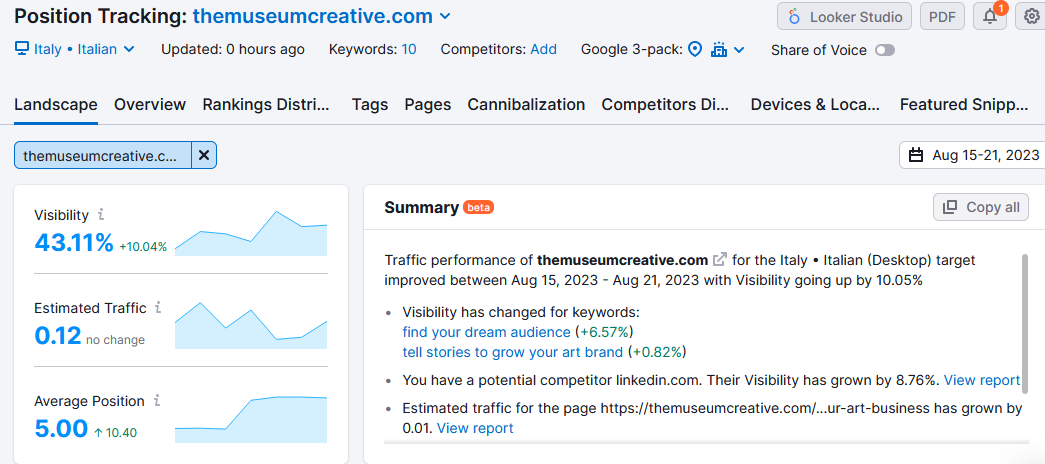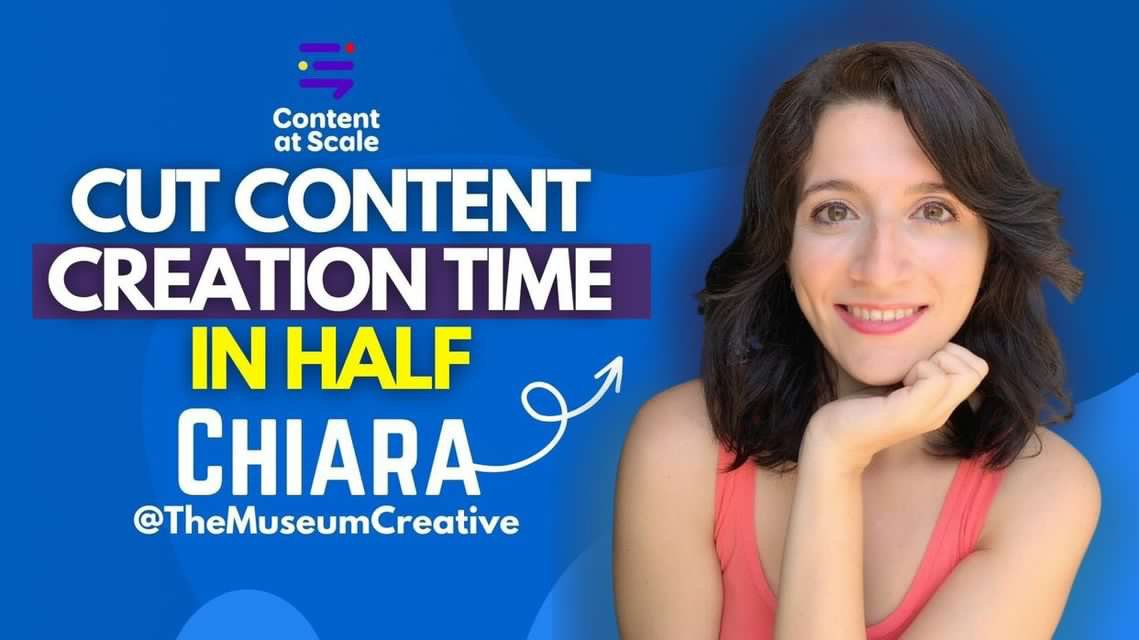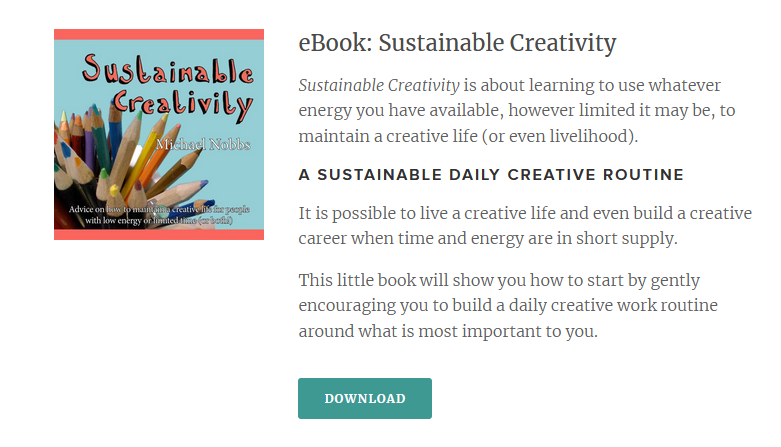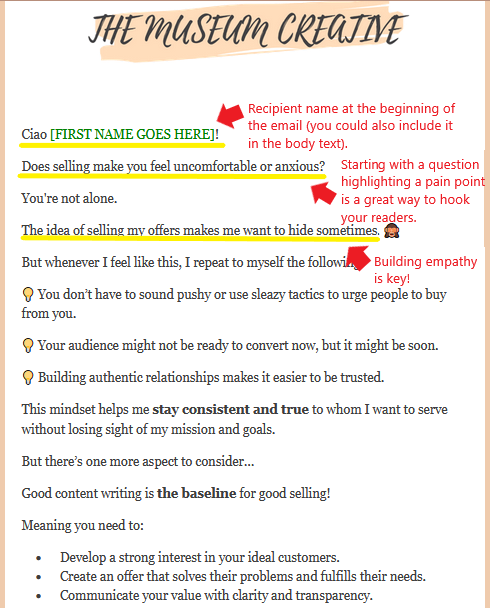How to Scale With Emails and SEO Blogging for Art Businesses
Are you aware that a staggering 61% of marketers say improving SEO and growing their organic presence is their top inbound marketing priority? 💡
Yet, many creative brands aren’t harnessing the power of SEO blogging for art businesses (70% lack an SEO strategy), nor do they invest in email list building for strategic audience development.
Shocking, right?
This oversight stems from ignoring how search engines and inbound content marketing work or solely relying on quick fixes and shortcuts like paid ads.
If this sounds familiar to you, it's not an uncommon occurrence.
Neglecting SEO blogging and email marketing may be why your art business isn’t thriving.
But it’s not too late for a change!
Combined, emails and SEO blogging for art businesses are two winning strategies for:
Amplifying your web traffic, reach, and influence.
Engaging with new, wider audiences.
Building a remarkable presence that your target audience loves.
Driving multiple conversions and sales.
They’re the perfect combo to achieve your marketing goals and grow a loyal fan base.
So, how do you unlock their potential for profitable results?
All you need to know is inside today’s blog.
Let’s dig in!
Emails and SEO Blogging for Art Businesses - Table of Contents
The Benefits of SEO Blogging for Art Businesses
Email Marketing: A Powerful Tool for Audience Engagement
The Synergy Between Blogging and Email Marketing
FAQs - Emails and SEO Blogging for Art Businesses
The Benefits of SEO Blogging for Art Businesses
Ever considered the incredible impact SEO-focused blogging can have on your art business?
Building a solid online presence is crucial to reaching potential customers and making sales.
And an effective way to boost it is through your art blogs enriched with smart SEO.
This strategy involves selecting specific focus keywords related to your industry, writing top-notch content aligned with your audience’s needs, and planning a consistent posting schedule.
But there’s more!
It’s about:
Amplified visibility on search results: Your blog posts serve as additional indexed pages for your website - which means more opportunities for you to appear in search engines and direct traffic to your site with relevant keywords and optimized content promoting your work and offers.
Organic audience growth: With blogging, you attract new visitors and build loyalty among existing followers. You regularly post fresh content to keep people coming back and share your blog posts across different platforms to reach wider audiences.
Increased reputation as a resource center for potential customers: An informative blog acts like an authoritative source of information about trending topics that interest your ideal audience. It shows that, apart from selling your offerings, you aim to educate them - increasing brand credibility and trust.
Expanded searchability: By applying strong SEO practices like using image alt tags on artwork images featured in your blog posts, you also extend visibility on Google image search results.
My website wouldn’t have reached position #5 on Google, with a visibility of up to 43.11%, in just one week if I had underestimated the power of consistent SEO-focused blogging:
That’s why you should invest in it ASAP!
Crafting Authentic, Trustworthy Content
In this digital era, being genuine as a brand is paramount (88% of consumers believe authenticity is essential when deciding what brands they like and support).
You create an intimate connection with readers by publishing personal stories in your blogs, behind-the-scenes content, how-to guides, or detailed case studies about your work in the art field.
My testimonial for BrandWell is an example of how sharing first-hand experiences can lead to lasting relationships with the audience:
This level of transparency enhances brand personality while fostering trust among prospects!
You not only highlight your expertise, and unique insights into your industry but also motivate readers to consume your helpful content and commit to your brand.
Driving Conversions through High-Quality Content
Beyond building trustworthiness, high-quality content helps generate more conversions and sales.
The rule of thumb is to investigate your audience through regular conversations to identify their main queries and pain points.
From there, you establish yourself as a thought leader by delivering valuable, informative posts that meet your readers’ expectations.
The authority gained this way will make your presence memorable and noteworthy!
To further raise engagement amongst website visitors, incorporate catchy calls-to-action (CTAs) into your pieces promoting your products/services.
Screenshot from: Go Gently.
CTAs guide users to make beneficial decisions like exploring other web pages or signing up for free incentives, special deals, or updates via email subscriptions.
Email Marketing: A Powerful Tool for Audience Engagement
Email marketing is another key tool in engaging your dream audience.
Sending subscribers personalized emails, containing actionable solutions, amplifies reach and triggers positive perceptions about your brand.
Here’s what to do.
Building An Email List
Before launching any email marketing campaign, you must grow a robust mailing list.
There are several ways to achieve this: you could run contests/giveaways involving sign-ups, promote lead magnets like a free workshop or ebook on your social platforms and art blogs, offer access to exclusive discounts upon subscription, or simply include a CTA promoting your newsletter on your website.
Screenshot from: Jane Hodgkiss.
All these are great approaches to spur enrollment - especially if you ensure your offers align with your community’s interests and needs!
Crafting Engaging Emails
Your ability to craft compelling, quality emails will largely determine the success of any campaign targeting brand awareness, conversions, or customer retention.
A crucial element here is personalization - using recipient names in the copy increases open rates by at least 50%!
But true personalization goes beyond just that; it's about tailoring content to user behavior patterns like past purchases, previous sign-ups to free lead magnets/events, or comments/queries on specific topics.
Here’s an idea of how to structure weekly customized emails:
Delivering relevant, consistent content keeps subscribers involved while positioning you as a notable, trusted authority.
So, keep your messaging authentic and updated on what matters most to your audience; do regular audience research and ask for feedback through surveys or email responses (you could add a P.S. with a question and an invitation to answer it at the bottom of your content piece).
The Synergy Between Blogging and Email Marketing
You may ask, “How can I effectively increase my online brand presence?”
The answer lies in the strategic combination of SEO blogging for art businesses and email marketing.
These two potent methods work hand-in-hand to drive website traffic, grow leads, and raise revenue while saving costs too (you’d spend 62% less than traditional marketing!).
They’re pivotal to be visible on search results and attract the right audience.
Plus, by crafting consistent, top-notch blogs that speak to your readers, you strengthen your reputation within the art world!
The following considerations will help you get the most out of this synergy.
1. Fueling Your Email Marketing Efforts Through Blogs
Well-crafted blogs are beneficial for higher website SEO rankings. No doubt.
But they’re ideal for fueling email marketing endeavors too!
Each new, long-form post is a chance to bond with readers, whether through organic Google searches or shared links on social channels - leading them back onto your website to take action towards your offerings.
Example of a newsletter form embedded into a blog post. (Laly Mille)
This enhanced flow of web traffic naturally drives curiosity in your brand, including more conversions from casual browsers to dedicated followers who sign up for regular emails from you.
2. Emails: Nurturing Relationships Beyond Blogs
Blog posts are incredibly beneficial to your presence.
They help with online traction, brand recognition, and notoriety.
But the journey doesn't end there.
By leveraging email marketing alongside SEO blogging for art businesses, you truly foster long-lasting relationships with your audience.
Emails let you interact directly with potential buyers who appreciate your content - and work! - setting the basics for brand advocacy.
For a more personal approach in your emails, include these three components:
Customization: use information gathered from user behavior data (most viewed content, interactions, questions, etc.) for personalized recommendations in emails.
Promotion: promote new blog posts via newsletters so subscribers don’t miss out on any updates from you.
Conversation: share insights about upcoming projects or exhibitions, sneak peeks of your creative process, current challenges, or the latest news about your business to trigger conversations and empathy.
Remember: high rankings through keyword-related strategies matter greatly. But, at its core, successful blogging is all about delivering value-adding experiences that keep users returning and ignite their desire to connect with you via emails!
3. Overcoming Challenges in Growing a Loyal Fan Base
Is it possible to overcome the hurdles of growing a loyal fan base from scratch?
Absolutely!
Let's explore some common challenges and practical solutions to address them.
Challenge 1: Consistent Creation of Engaging Content
The first challenge often encountered is maintaining consistency while producing content for your website, blog, emails, and social media.
In this case, an exceptional time management tactic is to develop a well-organized editorial calendar that schedules what content type you’ll publish on what specific dates.
Doing so ensures regular posting based on a system catered to your needs and goals.
Best of all, it provides ample time for brainstorming new creative ideas and curating other aspects of your business - all without stressing out!
Challenge 2: Building Trust with Prospective Customers
Earning trust from prospects is a strenuous process that requires time and patience.
To mitigate this concern:
Leverage your content to educate the audience about your brand’s mission and values.
Tackle their objections by showcasing your expertise and authenticity.
Fulfill their wants with helpful guidelines.
Feature positive testimonials and reviews to boost credibility further.
This way, you’ll stick into your ideal buyers’ minds longer and gain long-term support!
Challenge 3: Reaching Out To The Right Audience
Finding and connecting with the RIGHT audience is another obstacle when building a loyal following.
An efficient way out is to thoroughly study your audience before creating content and launching any marketing campaign.
Content audits, polls, discovery calls, feedback sessions - you name it - are all good opportunities to:
Learn what content formats resonate best with your audience.
Identify their demographics and habits.
Pinpoint their main struggles and demands.
Differentiate yourself on the market with your unique presence.
These findings will guide future strategies for attracting more relevant searches to your website/blog, increasing email subscriptions, and generating more customers!
FAQs - Emails and SEO Blogging for Art Businesses
How to do SEO for an artist or art institution?
SEO blogging for art businesses involves:
Streamlining your website with keywords related to your expertise area and target audience.
Creating inspiring, helpful blog content.
Building high-quality backlinks for better exposure.
Regularly updating your site, using image alt tags, and repurposing your high-performing content also work wonders for advanced visibility in search results.
How to do art blogging?
To start art blogging, choose a niche that fits your purpose.
Then, create informative posts around your activity, industry trends, and relevant topics piquing your audience’s interest.
Use SEO tips strategically to make your content searchable and interact with your readers through all your platforms for stronger connections.
Remember, consistency is key to maintaining high engagement!
How do I drive traffic to my art website?
To increase traffic, take these steps:
Implement SEO tactics like keyword optimization and quality link-building.
Promote your blogs on social media to hook more visitors.
Adopt email marketing campaigns to retain existing leads while attracting new ones.
This sustainable approach will help you grow a staunch community of brand ambassadors!
Pivot to Emails and SEO Blogging for Art Businesses for a Powerful Online Presence and Engagement Boost
SEO blogging for art businesses is more than just a marketing strategy; it's a revolution. 💥
It's about crafting authentic, trustworthy content that resonates with your audience and generates conversions.
Email marketing amplifies this effect, laying the foundation for deep relationships through high-value, personalized messages.
When working in synergy, these two strategies become the perfect mix to exponentially grow a dedicated fan base while boosting your rankings and revenue. 🚀
Add consistent dedication and careful planning to it, and you’ll have set the right path to propel your business forward!











